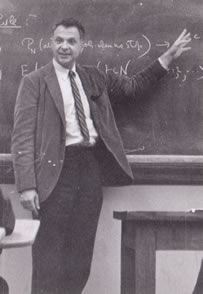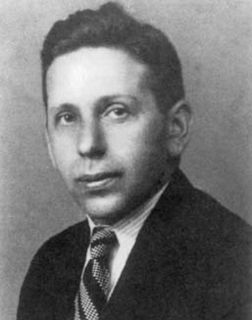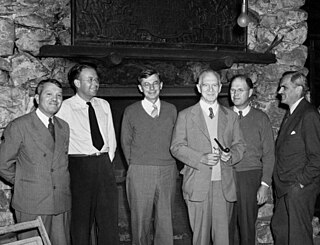Related Research Articles

Claude Elwood Shannon was an American mathematician, electrical engineer, and cryptographer known as "the father of information theory". Shannon is noted for having founded information theory with a landmark paper, "A Mathematical Theory of Communication", which he published in 1948.

Vannevar Bush was an American engineer, inventor and science administrator, who during World War II headed the U.S. Office of Scientific Research and Development (OSRD), through which almost all wartime military R&D was carried out, including important developments in radar and the initiation and early administration of the Manhattan Project. He emphasized the importance of scientific research to national security and economic well-being, and was chiefly responsible for the movement that led to the creation of the National Science Foundation.
Operations research (OR) is a discipline that deals with the application of advanced analytical methods to help make better decisions. The term operational analysis is used in the British military as an intrinsic part of capability development, management and assurance. Operational analysis forms part of the Combined Operational Effectiveness and Investment Appraisals, which support British defence capability acquisition decision-making.

Norbert Wiener was an American mathematician and philosopher. He was a professor of mathematics at the Massachusetts Institute of Technology (MIT). A child prodigy, Wiener later became an early researcher in stochastic and mathematical noise processes, contributing work relevant to electronic engineering, electronic communication, and control systems.
Warren Weaver was an American scientist, mathematician, and science administrator. He is widely recognized as one of the pioneers of machine translation, and as an important figure in creating support for science in the United States.
Howard Percy "Bob" Robertson was an American mathematician and physicist known for contributions related to physical cosmology and the uncertainty principle. He was Professor of Mathematical Physics at the California Institute of Technology and Princeton University.

Herbert Ellis Robbins was an American mathematician and statistician. He did research in topology, measure theory, statistics, and a variety of other fields.

Abraham Wald was a Hungarian Jewish mathematician who contributed to decision theory, geometry, and econometrics, and founded the field of statistical sequential analysis. One of the well known statistical works of his during World War 2 was how to minimize the damage to bomber aircraft taking into account the survivorship bias in his calculations. He spent his researching years at Columbia University.

The National Defense Research Committee (NDRC) was an organization created "to coordinate, supervise, and conduct scientific research on the problems underlying the development, production, and use of mechanisms and devices of warfare" in the United States from June 27, 1940, until June 28, 1941. Most of its work was done with the strictest secrecy, and it began research of what would become some of the most important technology during World War II, including radar and the atomic bomb. It was superseded by the Office of Scientific Research and Development in 1941, and reduced to merely an advisory organization until it was eventually terminated during 1947.

Samuel King Allison was an American physicist, most notable for his role in the Manhattan Project, for which he was awarded the Medal for Merit. He was director of the Metallurgical Laboratory from 1943 until 1944, and later worked at the Los Alamos Laboratory — where he "rode herd" on the final stages of the project as part of the "Cowpuncher Committee", and read the countdown for the detonation of the Trinity nuclear test. After the war, he returned to the University of Chicago to direct the Institute for Nuclear Studies and was involved in the "scientists' movement", lobbying for civilian control of nuclear weapons.

The Uranium Committee was a committee of the National Defense Research Committee (NDRC) that succeeded the Advisory Committee on Uranium and later evolved into the S-1 Section of the Office of Scientific Research and Development (OSRD), when that organization absorbed the NDRC in June 1941, and the S-1 Executive Committee in June 1942. It laid the groundwork for the Manhattan Project by initiating and coordinating the early research efforts in the United States, and liaising with the Tube Alloys Project in Britain.

Hendrik Wade Bode was an American engineer, researcher, inventor, author and scientist, of Dutch ancestry. As a pioneer of modern control theory and electronic telecommunications he revolutionized both the content and methodology of his chosen fields of research. His synergy with Claude Shannon, the father of information theory, laid the foundations for the technological convergence of the information age.
The Institute for Defense Analyses (IDA) is an American non-profit corporation that administers three federally funded research and development centers (FFRDCs) – the Systems and Analyses Center (SAC), the Science and Technology Policy Institute (STPI), and the Center for Communications and Computing (C&C) – to assist the United States government in addressing national security issues, particularly those requiring scientific and technical expertise. It is headquartered in Alexandria, Virginia.
Raymond David Mindlin was an American mechanical engineer, Professor of Applied Science at Columbia University, and recipient of the 1946 Presidential Medal for Merit and many other awards and honours. He is known as mechanician, who made seminal contributions to many branches of applied mechanics, applied physics, and engineering sciences.

Mina Spiegel Rees was an American mathematician. She was the first female President of the American Association for the Advancement of Science (1971) and head of the mathematics department of the Office of Naval Research of the United States. Rees was a pioneer in the history of computing and helped establish funding streams and institutional infrastructure for research. Rees was also the founding president and president emerita of the Graduate School and University Center at CUNY. She received the Public Welfare Medal, the highest honor of the National Academy of Sciences; the King's Medal for Service in the Cause of Freedom (UK) and at least 18 honorary doctorates.

The 389th Strategic Missile Wing is an inactive unit of the United States Air Force. Its last assignment was with the 13th Strategic Missile Division at Francis E. Warren Air Force Base, Wyoming, where it was inactivated on 25 March 1965.

Applied mathematics is the application of mathematical methods by different fields such as physics, engineering, medicine, biology, finance, business, computer science, and industry. Thus, applied mathematics is a combination of mathematical science and specialized knowledge. The term "applied mathematics" also describes the professional specialty in which mathematicians work on practical problems by formulating and studying mathematical models.
Loebe Julie was an American engineer who has been credited with inventing the first operational amplifier circuit with differential inputs (1943), a topology which allowed much greater versatility in applications circuits and remains in wide use today.
Roland George Dwight Richardson was a prominent Canadian-American mathematician chiefly known for his work building the math department at Brown University and as Secretary of the American Mathematical Society.
References
- MacLane, Saunders. "The Applied Mathematics Group at Columbia in World War II" in A Century of Mathematics in America, vol. 3 (ed. Peter Duren). Providence: American Mathematical Society, 1989.
- Owens, Larry. "Mathematicians at War: Warren Weaver and the Applied Mathematics Panel, 1942–1945" in The History of Modern Mathematics, vol. 2 (eds. David E. Rowe and John McCleary). Boston: Academic Press, 1989.
- Rees, Mina. "The Mathematical Sciences and World War II". The American Mathematical Monthly (1980), 87, 607–621.
- Wallis, W. Allen. "The Statistical Research Group, 1942–1945". Journal of the American Statistical Association (1980), 75, 320–330.